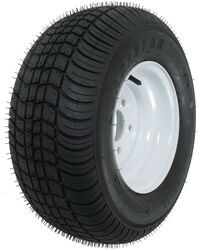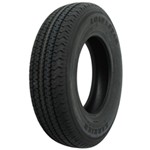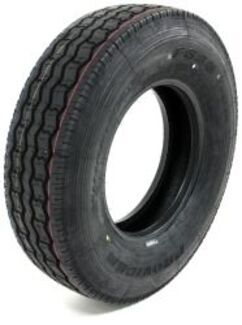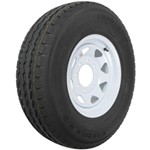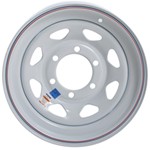
What is the Trade-off Between Wider and Narrower Tires?
Updated 04/27/2016 | Published 04/24/2016
Question:
Assuming clearance is not an issue : , what is the trade-off between wider and narrower tires? e.g. 205/65-10 LRB and 4.80-12 LRC? Same Diameter, same load ratings B,C but the 205 is 3inch wider. Great for beach and mud launching, a little 12V pump can get up to 35psi of the wider tire pretty easy, but whats the downside? I could *imagine* rolling resistance, does anybody know how much difference there really is? For bicycle tires, wider can be lower - so what work has been done on trailer tires in this area? if 205/65-10 is the answer, why not go to a 216/60-8 LRC? Does the rotation ~12 increase in rotation rate matter at all? Looking for good advice, the newsgroups are very info-poor on this subject!
asked by: Travis V
Expert Reply:
Typically, a wider tire will offer more stability, but with a small, light trailer any advantage provided by the wider tire would be tiny.
There are some differences in the two tires you mentioned that could possibally make the tire for your setup. The 205/65-10 LRB fits onto a 6 inch rim, while the 4.80-12 LRC fits a 4 inch rim width. They do indeed have the same overall diameter as you stated but the Load Range B 205/65-10 tire will be able to carry 910lbs at 35 psi while the Load Range C 4.80-12 can carry 990lbs at 90 psi. This means that the LRC 4.80 is capable of more capacity than the LRB tire. You will want to determine which rim width you have to determine which is best for your trailer.
Bias tires will do better in off road situations while radials will do better on roadways and highways.
A bias ply tire has a stiffer sidewall than a radial, a feature that might be useful for off road applications like farm use. A radial tire flexes more than a bias tire, giving it better ground contact, traction, stability, and tread wear. A radial tire will normally run cooler than a bias ply tire, especially when the tire is under a load. A tire that runs cooler will last longer.
You will want to be sure to keep trailer tires fully inflated to the pressure rating listed on the tire sidewall. Trailer tires perform best at their maximum pressure, as opposed to passenger vehicle tires. It sounds like you may want to deflate for better traction in sand or mud which is possible but you will need to be aware that this may lower the weigh capacity of the tires. You will also want to be sure that you re-inflate to the max psi before driving on the roadway again. There really is no downside except that to fill a 90 psi tire will take a lot more time than it will with a 35 psi tire.
Trailer tires are designed for load carrying purposes and not a lot of testing or work has been done to them compared to vehicle or bicycle tires like determining RPMs. A shorter tire will spin faster than a taller tire, so out of the tires you mentioned the 18.3 inch 215/60-8 tire will have the RPMs. Again the 215/60-8 tire will only mount onto a 7 inch rim, so you will be limited to the weight capacity and rim size currently on your trailer.
It's important to note that when trailer manufactures made these particular size tires they designed them to work for specific applications from a light seadoo trailer to a farm hail bail trailer.
I have linked a few Help Articles on tires and wheels for you to check out for your convenience.

Product Page this Question was Asked From
Kenda 205/65-10 Bias Trailer Tire with 10" White Wheel - 5 on 4-1/2 - Load Range C
- Trailer Tires and Wheels
- Tire with Wheel
- Bias Ply Tire
- Load Range C
- 205/65-10
- 10 Inch
- M - 81 mph
- 5 on 4-1/2 Inch
- Steel Wheels - Powder Coat
- Kenda
more information >
Featured Help Information
Miscellaneous Media

Continue Researching
- Shop: Kenda 5.70-8 Bias Trailer Tire with 8" White Wheel - 4 on 4 - Load Range D
- Shop: Vesper Steel Modular Trailer Wheel - 15" x 6" Rim - 5 on 5 - Black
- Article: How to Tell the Weight Rating of a Trailer Axle
- Shop: Kenda 5.70-8 Bias Trailer Tire with 8" White Wheel - 4 on 4 - Load Range C
- Shop: Loadstar K399 Bias Trailer Tire - 215/60-8 - Load Range C
- Shop: Kenda Loadstar K371 Bias Trailer Tire - 4.80/4.00-8 - Load Range B
- Q&A: What Does 5.70 and 8 Mean On a 5.70-8 Trailer Tire
- Q&A: Tips for Determining Square Trailer Axle Capacity
- Shop: Kenda 215/60-8 Bias Trailer Tire with 8" White Wheel - 4 on 4 - Load Range C
- Shop: Kenda 5.70-8 Bias Trailer Tire with 8" Galvanized Wheel - 4 on 4 - Load Range C
- Q&A: Load Capacity for Rackem Fitz-All Enclosed Trailer Ladder Rack
- Search Results: scissor
- Q&A: Total Extended Length of TJ01RT-HD Stabilizer Jack
- Q&A: Lug Nut Torque Chart for Trailer Wheels
- Article: 7 Common Questions Everyone Has About Trailer Tires
- Video: Stabilizer Jacks Review
- Video: All About the Loadstar ST175/80D13 Bias Trailer Tire with 13" White Wheel
- Video: Comprehensive Review: Scissor Stabilizer Jacks w/ Handle
- Video: Stabilizer Jack: The Breakdown
- Search Results: st175/80r13
- Video: All About the Karrier ST175/80R13 Radial Trailer Tire
- Video: In-Depth Review of the Loadstar ST175/80D13 Bias Trailer Tire
- Video: Hands-On with the Kenda ST175/80D13 Bias Trailer Tire
- Search Results: 570~8 trailer tires and wheels
- Q&A: What is the Smallest Overall Diameter Trailer Tire You Carry and What is the Speed Rating
- Q&A: Recommended 15 Black Wheels With A 5-On-5 Bolt Pattern
- Search Results: 6 lug wheels
- Shop: Brake Controller
- Search Results: 48~8
- Search Results: lug nuts



